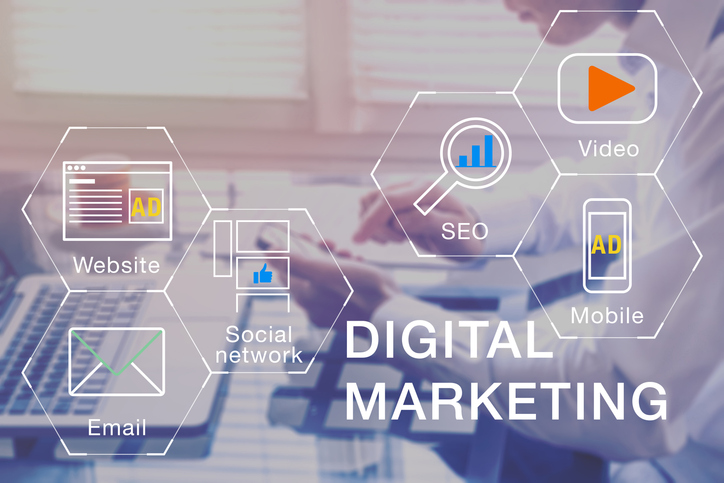
For small businesses, where resources are often limited and every decision carries more weight, taking a smart, deliberate approach can make the difference between steady growth and wasted effort.
This guide breaks down the essential components of a practical, results-driven digital marketing strategy that works for small businesses. It’s not about chasing trends or copying large companies—it’s about building a system that works for your goals, your audience, and your resources.
Key Takeaways:
- Define clear goals and know your target audience before launching any digital marketing effort.
- Audit your existing assets to find gaps and build a stronger foundation for future campaigns.
- Prioritize the channels and tools that match your customers’ habits and your business goals.
- Use content and video marketing to provide practical value and drive consistent engagement.
- Track performance data to refine your strategy and improve return on investment over time.
This guide breaks down the essential components of a practical, results-driven digital marketing strategy that works for small businesses. It’s not about chasing trends or copying large companies—it’s about building a system that works for your goals, your audience, and your resources.
1. Start With Specific Goals and a Clear Target Audience
Effective strategies always begin with a solid understanding of who the marketing is for and what it’s trying to accomplish. Vague goals like ‘get more followers’ or ‘increase awareness’ don’t provide enough direction. Instead, set goals you can measure—like increasing leads from organic traffic, boosting conversion rates on a landing page, or doubling your email subscriber list in six months.
Equally important is defining your target audience. Demographics are a start, but go further. What are their pain points? What motivates their decisions? How do they spend time online? These questions help shape your messaging, content, and choice of channels.
Tools like surveys, customer interviews, or simply reviewing data from your social media platforms and customer reviews can help refine your picture of the ideal customers you want to attract. If you’re still shaping your IT or digital structure to support these efforts, you can check out Computers Made Easy and other reliable service providers—their resources often give helpful insights into foundational tech support for small teams.
2. Audit What You Already Have and What You Need
Before creating new content or campaigns, take stock of your current online presence. This includes your website, blog posts, social media channels, and any past or active digital marketing campaigns. Are these aligned with your brand voice? Do they speak to your target audience? Are they generating the outcomes you want?
An audit helps you spot gaps in your messaging, content marketing consistency, and user experience. It’s also a good opportunity to assess the effectiveness of the digital marketing tools you’re currently using. Look at your CRM, email marketing platform, social media scheduler, and analytics setup. Identify what’s missing and where things may be underperforming.
Understanding the full picture can help you avoid unnecessary spending and instead redirect marketing efforts to where they can produce stronger returns. Curious how other small to mid-sized enterprises tackle these questions? You can read about WPG Consulting and other experienced consulting firms. They often share practical guidance on building scalable IT and marketing infrastructure.
3. Build a Website That Actually Converts
Your website is more than a brochure—it’s where interest turns into action. That action might be a purchase, a form submission, a phone call, or an email subscription. To support those actions, focus on responsive design, fast load times, clean navigation, and persuasive copywriting.
Every page should have a purpose, and that purpose should be obvious. Clear CTAs, simple forms, and messaging that reflects your customer’s journey can reduce friction and improve conversion rates. Add in trust signals like testimonials, real-time chat options, updated content, and clear contact details. These help build confidence and credibility for both new and current customers.
Think about how your site supports your wider goals—whether it’s generating leads, driving foot traffic to a physical location, or increasing average order value. The user experience should make it easy to move from curiosity to commitment.
4. Create a Content Calendar That Aligns With Strategy
Content creation is where many small businesses fall short. It’s easy to publish blog posts or social media updates without a plan. But for content marketing to be effective, it needs to be deliberate. That’s where a content calendar comes in.
Use your calendar to schedule content around your marketing plan, product or service cycles, seasonal trends, and industry events. Think about formats that fit your audience: how-to guides, FAQs, interviews, behind-the-scenes video content, or case studies. Use content to educate, inform, and solve problems—not just promote.
Incorporate a wide range of content types across multiple channels to increase reach. For example, a blog post can be repurposed into an email newsletter, a short video, a LinkedIn post, and an Instagram Story. This multiplies impact without multiplying effort.
5. Prioritize the Right Channels for Your Audience
Small businesses rarely have the time or budget to be everywhere. And that’s okay. Focus your energy on social media platforms and communication channels where your target audience is already active.
Instagram may work for a boutique retailer, while LinkedIn might be better for a B2B service provider. Facebook Groups can build a sense of community, and YouTube can provide space for deeper tutorials and storytelling. Select channels based on audience behavior, not popularity.
Email marketing remains one of the highest ROI channels available, especially for nurturing leads and staying in touch with loyal customers. Segment your list, personalize your messaging, and test your subject lines and layouts to improve engagement rates.
6. Use Paid Ads Strategically
Paid ads can extend your reach quickly, but they only work when backed by clear goals and a solid structure. Before spending anything, tighten up your funnel. Make sure your web design and landing pages load quickly, speak directly to your target audience, and feature one clear call to action. If visitors click but don’t know what to do next, you’ll lose them fast.
Start with a modest budget and treat it like a testing ground. Run A/B tests on headlines, visuals, and offers. Track metrics like cost per click, cost per acquisition, and return on ad spend. Use retargeting ads to re-engage people who visited your site but didn’t convert. These are often your warmest leads, and it usually costs less to bring them back than to find new prospects.
Keep your campaigns tightly focused. Instead of targeting broad interests, narrow in on location, behaviors, or job titles that match your ideal customers. Use ad scheduling to limit when your ads appear, especially if your audience is more active at specific times.
7. Encourage and Amplify User-Generated Content
Customer reviews, testimonials, and user-generated content build trust. People believe in other people more than they believe in brands. Encourage current customers to leave honest feedback or share their experiences on social media. Feature their content where appropriate—on your site, in newsletters, or in digital marketing campaigns.
This helps create a sense of community and shows that your business values its relationships with customers. It also supports your online reputation and adds credibility to your marketing messages.
8. Incorporate Video Marketing Thoughtfully
You don’t need a studio setup to create effective video content. Most smartphones shoot in high enough quality for web use, and authenticity often resonates more than polish. Focus on videos that serve a purpose—show how a product works, answer frequent questions, or highlight a real customer experience. Keep it simple and centered on the viewer’s needs.
Short-form videos tend to perform best, especially on social media platforms where users scroll quickly. Aim for 30 to 60 seconds for most posts, and use captions to capture attention even when the audio is off. If you’re recording tutorials or walk-throughs, break longer topics into smaller parts to keep engagement steady across segments.
For distribution, upload directly to each platform for better visibility, rather than linking from another source. Use clear thumbnails, keyword-rich descriptions, and relevant tags to improve reach through search engines. Over time, review engagement metrics like watch time, click-through rates, and drop-off points to refine your video content strategy.

9. Track What Matters, Not Just What’s Easy
Page views and likes are easy to collect but rarely tell the full story. Focus instead on key metrics that connect to actual business outcomes. For example, how many leads your content generates, how many email subscribers convert to buyers, and how many return visits result in purchases.
Set up dashboards or reports that help you track performance over time. This allows you to adjust your marketing plan based on what’s working. Over time, data helps refine your strategy and improve your return on investment.
10. Focus on Relationships, Not Just Reach
Business growth doesn’t always come from finding more people. Often, it comes from serving existing customers better. Strong customer service, consistent communication, and thoughtful follow-up can lead to repeat purchases, referrals, and a stronger online reputation.
Social media strategy shouldn’t just be about broadcasting. It should include listening, responding, and participating. Building relationships creates deeper connections and long-term value.
Final Thoughts on Building Your Strategy
Creating a digital marketing strategy that supports real business growth takes focus and follow-through. It starts with clear goals, a deep understanding of your audience, and a structure that allows you to stay consistent over time. Each part of your strategy should serve a specific purpose, from the content you publish to the platforms you choose.
Smaller teams don’t need to do everything at once. Prioritize what delivers value, test what works, and make steady adjustments based on real feedback and results. A strategy grounded in purpose and backed by data will always outperform guesswork.
